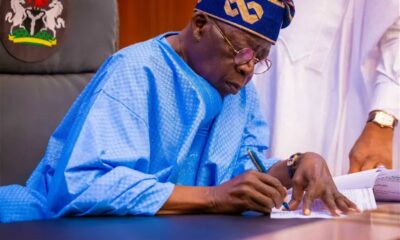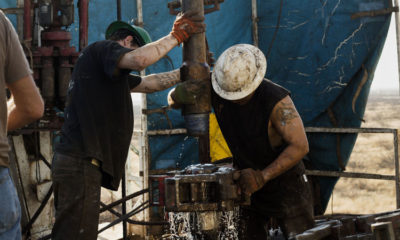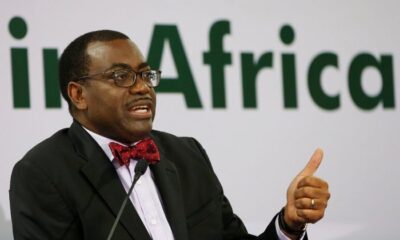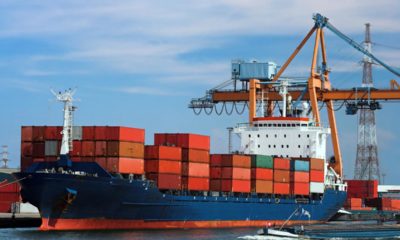Markets
Uncertainty Over N4.314tr Revenue from Marginal Fields
Published
7 years agoon
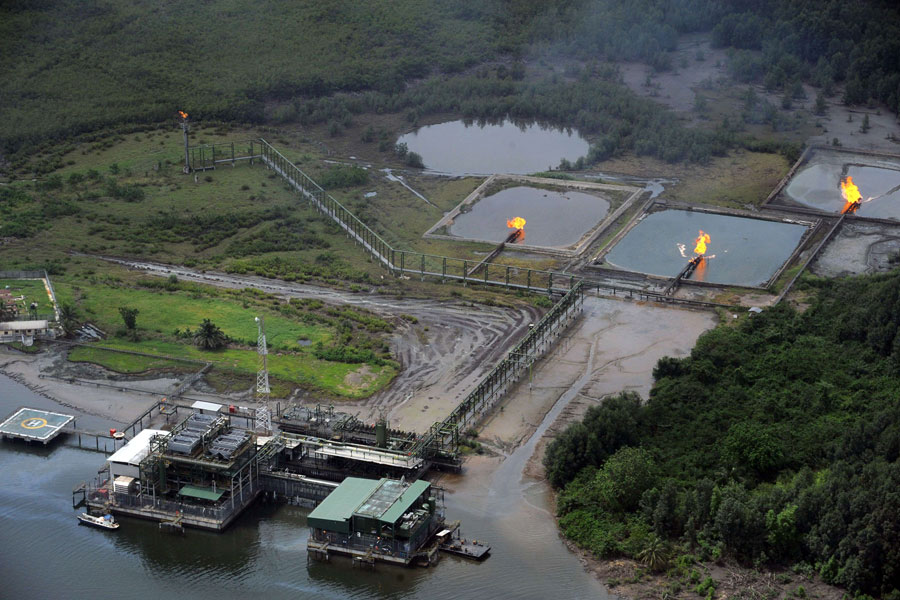
- Uncertainty Over N4.314tr Revenue from Marginal Fields
The nation’s plan to earn additional $14.100 billion (N4.314 trillion) from 300 million barrels of crude oil is uncertain as licensed marginal fields are unable to engage in meaningful exploration and production activities 13 years after.
The country targets daily earnings of $4.23 million (N1.29 billion) from an average of 90,000 barrels of oil per day. Experts say that 18 of the marginal fields with an average capacity of 5,000 bpd each could produce 90,000 bpd of crude oil.
This leakage is a major loss to the economy as the revenue would have been used to plug budget deficits and provide infrastructure that would boost national development.
Data from the Nigerian National Petroleum Corporation (NNPC) indicate that the Federal Government has 200 fields classified as marginal by operators due to low-ranking in investment portfolio and/or remoteness to existing facilities.
According to the NNPC, of the 200 fields, 24 granted licences by the Department of Petroleum Resources (DPR) have an estimated reserve of about 300 million barrels of crude. Of the 30 marginal fields awarded by the government since 2004, only 12 are active. It was learnt that18 of these licences have been classified as non-producing and require the farmees to relinquish the assets (having had the opportunity of a licence renewal after the initial five years duration expired).
The marginal fields awarded cumulatively produce around 2.6 per cent of daily oil production and 2.5 per cent of the estimated 4,000 MMscf gas productions in the country, due largely to the inability of indigenous firms to fully monetise the assets.
The producing wells, according to the latest statistics from the DPR, are Egbaoma Oil Mining Licence (OML) 38 belonging to Platform Petroleum; Ebendo OML 56 belonging to Energia Limited; OML 56 Omusati, Pillar Oil Limited; OML 56 Ebok, Oriental Energy; OML 54 Ogbelle, Niger Delta Petroleum Limited; and OML 56 Umusadege, Midwestern Oil and Gas.
Others are OML 90 Ajapa, Brittania-U Nigeria Limited; OML 16 Ibigwe, Walter Smith Petroleum Oil Limited; OML 13 Uquo, Frontier Oil Limited; Universal Energy and Network Exploration and Production.
DPR listed some of the non-producing marginal fields to include Oil Mining Licences (OML) 54, Omerelu oil field operated by Niger Delta Petroleum Limited; Otakikpo OML 11, Green Energy International; Ubima OML 17, All Grace Energy; Okwok OML 67, Oriental Energy; Amoji OML 56, Chorus Energy; Ekeh OML 88, Mavido Exploration and Production; and Oriri OML 88, Goland Petroleum.
Others are Ke OML 54, Del Sigma Limited; Dawes Island OML 54, Eurafric Energy; Ogedeh OML 90, Bicta Energy System; Akepo OML 90, Sogenal Limited; Ororo OML 95, Guarantee Petroleum; and Asaramatoru OML 11, Prime Energy Limited.
The discovery of one of the non-producing fields, Okwok, was made by a joint venture between NNPC and Mobil Producing Nigeria, a subsidiary of ExxonMobil.
According to the latest estimates, Okwok contains more than 70 million barrels of recoverable oil reserves. The stock tank oil initially in place (STOIIP) is estimated to be 225 million barrels of oil.
Akepo Field (OML 90’s) total proven reserves are estimated at 81 million barrels. The probable reserves are estimated at 410 million barrels and possible reserves at 1.243 billion barrels.
Asaramatoru marginal field is an onshore field in Rivers State with Shell/NNPC and JV partners as leaseholder. The field is estimated to contain a recoverable reserve of 28 mbbl of oil and 2.7 bscf of associated gas. Stubb Creek field is estimated to contain 20 mmbbl oil and 450 bscf of gas (proven and probable reserves). Ekeh oil field owned by Movido Exploration and Production has a reserve base of 25 million barrels and is yet to take off.
Also, Otakikpo marginal oil field operated by Green Energy International has an estimated 56.75 million barrels of oil (mmbbl), with an additional 70 billion cubic feet (bcf) of gas reserves.
Ogedeh Field (OML 90) is an oil and gas field located in the shallow water offshore Niger Delta. It is fully covered by 3D seismic, and the technical analysis indicates that the Ogedeh licence area holds hydrocarbon prospective resources likely to be in the range of 10 to 25 million barrels of oil, with gas reserves in the order of 25 BCF.
On the issue of idle marginal field, President of Nigeria Association of Petroleum Explorationists (NAPE), Abiodun Adesanya, said that International Oil Companies (IOCs) made these discoveries. “Later they did not meet the threshold of their corporate size and therefore they keep them idle. But that might change somebody else’s life and so opportunity should be given to such a person,” he said.
According to Adesanya, some of the fields are idle because the funding is not in place to develop them, especially the government’s part of the funding. “Even though government has come up with a plan to let each project go out to the capital market to raise funds for itself, it is a good idea, but you have a backlog from the higher valued ones until you trickle down,” he said.
Also, Managing Director and Chief Executive Officer of Energia Limited, Felix Valentine Amieyeofori, said that there was the need to structure a marginal field company to look like an exploration and production company.
“There are lots of co-ventures and partnership issues. There are technology and experience gaps, and rather than use local or foreign experts, some of the marginal fields’ operators still resort to the use of the trial and error method of restructuring.”
On the issue of finance, Amieyeofori, noted: “Some of us who have been in production, we are trying to tell them the different models of financing. It does not have to be the banks.
“There are service companies that are ready to finance marginal field companies and then get paid on production. There are people that are off takers who can give money to develop these fields and there is a guarantee to lift up the crude.”
The Chairman of Petroleum Technology Association of Nigeria, Bank Anthony Okoroafor, stated that Nigeria’s target of increasing our crude oil reserves to 40 billion barrels and production to four million barrels per day could only be achieved when we invest in explorations and developments. “New blocks should be given out for people to explore. We should conduct blocks and marginal bid rounds so people will explore and share with government; incentivise people to come and explore new areas; new bid rounds under laws that are friendly to investors,” he added.
Meanwhile, the NNPC has said it saves about $3billion annually from the reduction of crude oil operation costs since 2015.
The corporation also drove the cost of crude oil production down from $78 dollars per barrel as at August 2015 to $23 per barrel representing 70.5% reduction.
The Group General Manager of National Petroleum Investment Management Services (NAPIMS), a unit of NNPC, Dafe Sejebor, disclosed this during the inauguration of the anti-corruption committee of the unit.
Sejebor said NAPIMS arrived at the figure after looking at the difference between the $78 and $23 which represents the old and new costs of production in relation to the present daily average production in the country.
“If you knock down your cost of production from $78 per barrel to $23, take the difference and multiply by the average daily production, you will discover that we are saving a minimum of $3billion in the upstream for both Production Sharing Contracts (PSCs) and Joint Ventures (JVs),” he said.
The GGM disclosed that the target was to bring the cost of production to between $17 and $19 for onshore and offshore production.
He commended the Federal Government for its support to the NNPC management in tackling the challenges in the petroleum industry, especially the cash call exit agreement signed in 2016 and the reduction of contracting circle from three years to six months.
Is the CEO and Founder of Investors King Limited. He is a seasoned foreign exchange research analyst and a published author on Yahoo Finance, Business Insider, Nasdaq, Entrepreneur.com, Investorplace, and other prominent platforms. With over two decades of experience in global financial markets, Olukoya is well-recognized in the industry.

You may like
-
Nigeria Joins BRICS as Partner Country, Strengthening Global South Cooperation
-
70 Million Poorest of The Poor Nigerians To Get N75,000 From FG
-
Nigeria Surpasses OPEC Quota with 1.51 Million bpd, Targets 2.06 Million in 2025
-
Global Investors Commit $7.6 Billion to Nigeria’s Development at AIF 2024
-
Nigeria-China Trade Strengthened as Grimaldi Introduces Direct Shipping Line
-
Nigeria’s GDP Records 3.46% Growth in Q3 Spurred by Non-Oil Sector



